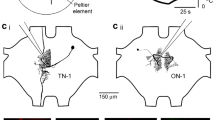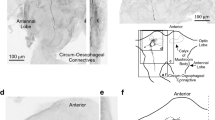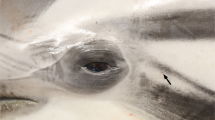Summary
Intracellular recording and staining techniques have been used to investigate physiological and anatomical properties of two kinds of auditory interneurons in the prothoracic ganglion of the crickets,Gryllus campestris L. andGryllus bimaculatus DeGeer: a segmental interneuron (the omega cell) and an auditory interneuron with an ascending axon (AIAA).
Using cobalt-nitrate-filled electrodes we were able to study physiological features for periods as long as 10 min following penetration and simultaneously stain the cell. With potassium-acetate electrodes, similar intracellular recordings lasted longer than an hour.
-
1.
The omega cell is a large segmental auditory neuron with four branching areas (fields A, B, C, D). Two such cells are found in the prothoracic ganglion, as mirror images of one another.
-
2.
The omega cell receives its auditory input entirely from the cell-body side. EPSPs as well as spike activity are seen in the large dendritic root of field A; the spikes are conducted to the contralateral side of the neuron and invade fields C and D, which are considered to be output areas of the neuron.
-
3.
When the two ears are isolated acoustically, allowing separate stimulation of the tympana, it appears that the two omega cells inhibit one another mutually. They may, therefore, participate in the neuronal mechanism involved in directional sensitivity.
-
4.
The omega cell is best tuned to the carrier frequency of the conspecific song, but exhibits a secondary threshold minimum in the region of the higher harmonics. The response is linearly related to the log of the sound intensity, as found in the auditory afferents.
-
5.
The temporal pattern of the cricket calling song is well copied by the omega cell. No optimal “tuning” to specific syllable durations, syllable periods or verse durations was observed. Maintained tones elicit a tonic response and sound envelopes are mimicked by both subthreshold and spike-activity.
-
6.
The auditory interneuron with ascending axon (AIAA) has a dendritic field and ascending axon restricted almost entirely to one hemisphere of the prothoracic ganglion; the cell body is located in the anterior contralateral hemisphere.
-
7.
The AIAA exhibits IPSPs highly synchronized in response to sounds presented at the carrier frequency. At sound frequencies above 10 kHz the AIAA is activated, but the responses to the syllables of the calling song are not as sharply separated as in the omega cell.
-
8.
Latencies of AIAA spike activity are comparable to those in the omega cell and suggest that both cells are first order interneurons.
-
9.
The frequency-dependence of excitation and inhibition in the AIAA make it a candidate element of a neuronal process that might modify response to the calling song in the presence of the courtship song.
Similar content being viewed by others
Abbreviations
- AIAA:
-
auditory interneuron (with an) ascending axon
References
Bacon, J.P., Altman, J.S.: A silver intensification method for cobalt-filled neurons in wholemount preparations. Brain Res.138, 359–363 (1977)
Bentley, D.: Intracellular activity in cricket neurons during generation of song patterns. Z. vergl. Physiol.62, 267–283 (1969)
Burrows, M.: The role of delayed excitation in the coordination of some metathoracic flight motoneurons of a locust. J. comp. Physiol.83, 135–164 (1973)
Burrows, M.: Monosynaptic connexions between wing stretch receptors and flight motoneurones of the locust. J. exp. Biol.62, 189–219 (1975)
Casaday, G.B., Hoy, R.R.: Auditory interneurons in the cricketTeleogryllus oceanicus: physiological and anatomical properties. J. comp. Physiol.121, 1–13 (1977)
Eibl, E.: Morphologische und neuroanatomische Untersuchungen zur Sinnesorganausstattung der proximalen Tibienabschnitte und ihrer zentralen Projektionen bei Grillen. Dissertation, Universität zu Köln, Köln 1976
Eibl, E., Huber, F.: Tympanal nerve fibers in the cricketsGryllus campestris L. andGryllus bimaculatus DeGeer: Projections in the prothoracic ganglia, as compared with those of homologous meso- and metathoracic nerves. Zoomorphologie, in press (1978)
Elepfandt, A.: Auditory interneurons in the mesothoracic ganglion of the cricket,Gryllus bimaculatus DeGeer. Verb. Deutsch. Zool. Ges. 71. Jahrestagung, Konstanz, 1978
Elsner, N., Popov, A.V.: Neuroethology of acoustic communication. Adv. Insect Physiol.13, 229–335 (1978)
Erber, J., Menzel, R.: Visual interneurons in the median protocerebrum of the bee. J. comp. Physiol.121, 65–77 (1977)
Esch, H., Huber, F., Wohlers, D.: Physiological and anatomical characteristics of single sensory auditory units in crickets (Gryllus campestris L. andGryllus bimaculatus DeGeer), in preparation (1978)
Fielden, A.: Transmission through the last abdominal ganglion of the dragonfly nymph,Anax imperator. J. exp. Biol.37, 832–844 (1960)
Hagiwara, S., Watanabe, A.: Discharges in motoneurons of cicada. J. Cell. Comp. Physiol.47, 415–428 (1956)
Hausen, K.: Functional characterization and anatomical identification of motion sensitive neurons in the lobula plate of the blowflyCalliphora erythrocephala. Z. Naturforsch.31 c, 629–633 (1976)
Hill, K.: Acoustic communication in the Australian field cricketsTeleogryllus commodus andT. oceanicus (Orthoptera: Gryllidae). Ph. D. thesis. University of Melbourne, Melbourne, Australia 1974
Hill, K.G., Boyan, G.S.: Directional hearing in crickets. Nature262, 390–391 (1976)
Hill, K.G., Boyan, G.S.: Sensitivity to frequency and direction of sound in the auditory system of crickets (Gryllidae). J. comp. Physiol.121, 79–97 (1977)
Huber, F.: Lautäußerungen und Lauterkennen bei Insekten (Grillen). 26. Jahresfeier Rheinisch Westfälische Akademie der Wissenschaften: N265, 15–66. Opladen: Westdeutscher Verlag 1977
Huber, F., Stout, J.F.: Coding of sound patterns by ascending neurons in the auditory pathway of the cricket,Gryllus campestris L. Verh. Deutsch. Zool. Ges. 71. Jahrestagung, Konstanz, 1978
Kalmring, K.: The afferent auditory pathway in the ventral cord ofLocusta migratoria (Acrididae). I. J. comp. Physiol.104, 103–141 (1975)
Kater, S.B., Nicholson, C.: Intracellular staining in neurobiology, Berlin-Heidelberg-New York: Springer 1973
Kien, J.: A preliminary report on cobalt sulphide staining of locust visual interneurones through extracellular electrodes. Brain Res.109, 158–164 (1976)
Larsen, O.N., Michelsen, A.: Biophysics of the ensiferan ear III. The cricket ear as a four-input system. J. comp. Physiol.123, 217–227 (1978)
Nocke, H.: Physiological aspects of sound communication in crickets (Gryllus campestris L.). J. comp. Physiol.80, 141–162 (1972)
Paton, J.A., Capranica, R.R., Dragsten, P.R., Webb, W.W.: Physical basis for auditory frequency analysis in field crickets (Gryllidae). J. comp. Physiol.119, 221–240 (1977)
Pearson, K.G., Fourtner, C.R.: Nonspiking interneurons in walking system of the cockroach. J. Neurophysiol.38, 33–52 (1975)
Popov, A.V.: Frequency selectivity of the reaction of auditory neurons in the 1st thoracic ganglion of the cricketGryllus bimaculatus DeGeer. Jurnal Evol'uzionnoj Biochimii i Fiziologii9, 265–277 (1973)
Popov, A.V., Shuvalov, V.F., Svetlogorskaya, I.D., Markovich, A.M.: Acoustic behavior and auditory system in insects. In: Mechanoreception (ed. J. Schwartzkopff): Rheinisch Westfälische Akad. d. Wiss., Abh.,53, 281–306 (1974)
Rehbein, H.G.: Auditory neurons in the ventral cord of the locust: morphological and functional properties. J. comp. Physiol.110, 233–250 (1976)
Rehbein, H.G., Kalmring, K., Römer, H.: Structure and function of acoustic neurons in the thoracic ventral nerve cord ofLocusta migratoria (Acrididae). J. comp. Physiol.95, 263–280 (1974)
Rheinlaender, J., Kalmring, K., Popov, A.V., Rehbein, H.G.: Brain projections and information processing of biologically significant sounds by two large ventral cord neurons ofGryllus bimaculatus DeGeer (Orthoptera, Gryllidae). J. comp. Physiol.110, 251–269 (1976)
Stout, J.F., Huber, F.: Responses of central auditory neurons of female crickets (Gryllus campestris L.) to the calling song of the male. Z. vergl. Physiol.76, 302–313 (1972)
Stout, J.F., Huber, F.: Pattern coding in some ascending auditory neurons ofGryllus campestris L, in preparation (1978)
Suga, N.: Central mechanism of hearing and sound localization in insects. J. Insect Physiol.9, 867–873 (1963)
Tyrer, N.M., Bell, E.M.: The intensification of cobalt-filled neuron profiles using a modification of Timm's sulphide-silver method. Brain Res.73, 151–155 (1974)
Weber, T.: Comparative aspects of the calling songs in three cricket species with respect to species specific recognition in female phono taxis. Verh. Deutsch. Zool. Ges. 71 Jahrestagung, Konstanz, 1978
Wiese, K.: Temporal and spatial filtering by the omega neuron in the acoustic ascending pathway ofGryllus bimaculatus DeGeer, in preparation (1978)
Wohlers, D., Huber, F.: Anatomical and physiological characterization of intracellularly recorded and stained acoustical neurons inGryllus campestris L. andGryllus bimaculatus DeGeer. Verh. Deutsch. Zool. Ges. 71 Jahrestagung, Konstanz, 1978
Zaretsky, M.D.: Patterned response to song in cricket central auditory neurone. Nature229, 195–196 (1971)
Zhantiev, R.D., Kalinkina, I.N., Tshukanov, V.S.: The characteristics of the directional sensitivity of tympanal organs inGryllus bimaculatus DeGeer (Orthoptera, Gryllidae). Entomol. Obozr.54, 249–256 (1975a)
Zhantiev, R.D., Kalinkina, I.N., Tshukanov, V.S.: Functional characteristics of two auditory interneurons in the cricketGryllus bimaculatus DeGeer (Orthoptera, Gryllidae). Vestnik MGU, Ser. Biol.6, 18–25 (1975b)
Zhantiev, R.D., Kalinkina, I.N.: Sound reaction of descending neurons in the abdominal central nervous system. Nauchn(ye) dokl(ady) vysshei shkoly20, biol. nauki, No. 8, 66–71 (1977)
Zhantiev, R.D., Korsunovskaya, O.S.: Reaction to sound of descending neurons in cervical connectives of the cricketGryllus bimaculatus DeGeer (Orthoptera, Gryllidae). Entomol. obozr.54, 248–257 (1977)
Zhantiev, R.D., Tshukanov, V.S.: Frequency characteristics of tympanal organs of the cricketGryllus bimaculatus DeGeer (Orthoptera, Gryllidae). Vestnik MGU, Ser. Biol.2, 3–8 (1972a)
Zhantiev, R.D., Tshukanov, V.S.: Reaction of the auditory system ofGryllus bimaculatus (Orthoptera, Gryllidae) to intraspecific sound signals. Zool. J.51, 983–993 (1972b)
Author information
Authors and Affiliations
Additional information
Supported by a Stipendium of the Max Planck Gesellschaft
Supported by the Deutsche Forschungsgemeinschaft within the SPP „Neurale Mechanismen des Verhaltens“ (Hu 35/17)
We are grateful to Dr. U.T. Koch for his invaluable assistance with electronic equipment he designed to solve sound-field problems confronted when working with acoustical stimulation. We thank Dr. J. Thorson for his critical reading of the manuscript. We are also grateful to Ms. H. Bamberg for her assistance with the figures.
Rights and permissions
About this article
Cite this article
Wohlers, D.W., Huber, F. Intracellular recording and staining of cricket auditory interneurons (Gryllus campestris L.,Gryllus bimaculatus DeGeer). J. Comp. Physiol. 127, 11–28 (1978). https://doi.org/10.1007/BF00611922
Accepted:
Issue Date:
DOI: https://doi.org/10.1007/BF00611922




